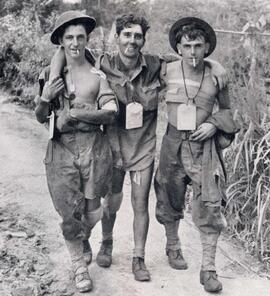LETHBRIDGE, Maj Gen John Sydney (1897-1961)
- LETHBRIDGE
- Collection
- 1939-1961
Papers chiefly related to Lethbridge's service in the Second World War, 1943-1948 and the Control Commission, 1945-1948. Typescript report, photographs, glass photographic slides and correspondence relating to 220 Lethbridge Mission to the USA, India, South West Pacific and Australia to study tactics and equipment required to defeat Japan in the Far East, 1943-1944. Photographs, including album of Australian troops in action with Japanese, Papua New Guinea, 1943, with related publications, notably War in New Guinea (Department of Information, Australia, 1943) and The Australasians [27 Nov 1943], with profile of Lethbridge. Papers relating to Lethbridge's service as Chief of Staff, 14 Army, Burma, 1944-1945, including printed chart of the planned phases of the Burma campaign, 1944; letters home, Aug 1944-Jun 1945; personal letter from Gen Sir William Joseph Slim, Commander in Chief, Allied Land Forces, South East Asia, to Lethbridge, 26 Sep 1945; typescript operational and administrative notes on the Burma campaign, 1945; portrait photographs, including Gen Slim [1945]; typescript administrative memoranda, 1945; edition ofCampaign in Burma (Central Office of Information, London, 1946). Papers relating to Control Commission for Germany, 1945-1948, including photocopies of Hitler's last will and testament, with copies of translations, 1945; Lethbridge's notes on evidence for Hitler's death, 1945; Hitler's signed Christmas card [1944]; press cuttings relating to defeat of plot by former SS officers, 1947; two UK Government papers on anglo-German relations and on conditions in Germany (HMSO, London, 1939); photograph album of pre-war Berlin, with notes on post war condition [1946]. Photographs and press cuttings relating to the opening of the Civil Defence College, Sunningdale, Berkshire, 1950; photographs relating to Civil Defence exercise, Bristol, 1956. Obituary for Lethbridge, reprinted from The Royal Engineers Journal [1961].
Lethbridge, John Sydney, 1897-1961, Major General


